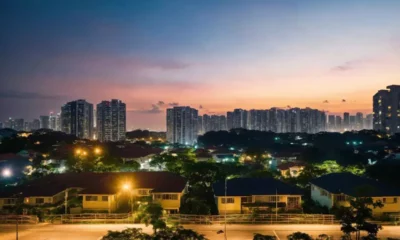Guest Column
Roadblocks to sustainable realty in India




The reasons for the relatively slow growth of India’s green real estate sector can be defined at different levels. At the policy level (Centre and state), the scale of policy-level incentives continues to be a constraint for manufacturers of green technologies, products and equipment as also for developers and consumers of green buildings. To be more precise, the incentives being offered a re not consistent across all states, and in states where they exist, the implementation mechanism is not aligned to the expected throughput.
While environmental clearance norms have gained traction over the years, this has arguably had a negative i m pact on growth because states have not evolved the adoption of appropriate and adequate machinery to ensure that clearances a re accorded objectively and most importantly in time. This has created a backlog which has further slowed the growth of green real estate.
As a result, the process of providing environmental clearances while being preferential for green buildings, is inherently slow, resulting in reduced effectiveness of this incentive. From the perspective of developers, there a p pear to be limited incentives for enabling green initiatives and current technologies a re either too expensive or do not address the requirements of such projects.
While proactive efforts such as providing extra FSI for projects that incorporate green initiatives and property tax rebates for green developments have been made by some local bodies, they a re not prevalent on a large scale.
Lack of consumer awareness
From the consumers’ perspective, there is a need for creating higher awareness a bout the long-term benefits of patronizing green developments. In terms of awareness, one of the most commonly lacking aspects is a g rasp of the short term cost versus long-term benefits of mainstreaming green initiatives. Awareness on green real estate needs to be boosted by some compelling case studies.
Most of the case studies that exist today a re of developments outside India, so they do not tend to inspire developers. Such case studies need to be presented to tenants and land lords with metrics that makes them compel ling for both developers and consumers to opt for the Green Alternative. Such adaptation is not too much in evidence today, with extremely limited and piecemeal efforts.
Measures that can boost growth
Among the interventions that would aid the growth of the green real estate sector in India, consistency and effectiveness of both legislation and incentives is probably paramount.
At the level of urban local bodies, efforts need to be made to perform cost- benefit analyses of mainstreaming green initiatives/technologies and designing incentives that will spur demand for green developments. These need to be viewed from the perspective of city-level infrastructure (transport, roads and intelligent technologies) and individual developments (residential, commercial office, retail and industrial).
• The process of providing environmental clearances while being preferential for green buildings, is inherently slow, resulting in reduced effectiveness of this incentive.
• One of the most commonly lacking aspects is a grasp of the short-term cost versus long-term benefits of mainstreaming green initiatives.
• Most of the case studies that exist today are of developments outside India, so they do not tend to inspire developers, Such case studies need to be presented to tenants and landlords with metrics that make them compelling for both developers and consumers to opt for the Green Alternatives.
• Among the interventions that would aid the growth of the green real estate sector in India, consistency and effectiveness of both legislation and incentives is probably paramount.
At the developer-level, platforms need to be created that a l l ow for a higher level of interaction between entrepreneurs who d rive technological innovations and manufacture products that promote green developments, and developers who may consider adopting these technologies. These platforms could allow for customized solutions for varying scales of projects with a view to according benefits to both stakeholders.
Additional awareness d rives need to be undertaken to enhance consumers’ understanding of the Green Prerogative and its holistic benefits. These awareness drives could b e promoted a t t h e level of RWAs (Resident Welfare Associations) where interactive platforms ca n be created with entrepreneurs who a re manufacturing green technologies and end users. Such d rives could result in innovative solutions both at individual household and neighbourhood/community levels. A proactive outreach to end consumers with a view to making green real estate more attractive at a macro level is, in fact, a key factor.
A cue can be taken from the success of the energy star programme for consumer appliances. With more than 60 per cent of future development likely to be residential, it makes a lot of sense to ensure that green real estate rides on intensive awareness programs and incentives, such as:
• Tax rebates for buyers of green equipment
• Property tax breaks/holidays for green property owners to offset initial capital expenditure
• Lucrative financing options for the purchase of green equipment and green real estate
Another concept that earlier saw a significant amount of global discussions is ensuring that some amount of direct, unobstructed sunlight is available to each unit for a minimum number of fixed hours in a day. Making this mandatory through mechanisms, such as bye laws for all new developments, would force building designs to be more responsive to climatic conditions via geometrical alignments. We need a widespread adoption and endorsement of the Energy Conservation Building Code (ECBC).
This ‘passive response’ measure wou l d reduce energy consumption without any additional expenditure, merely by design interventions. I n addition, existing b u i l d i n g stock needs to be addressed through performance reporting and rewards. Also, the cost of green power needs to be at par with or lower than traditional power. The baseline objective behind such initiatives would be to boost consumer demand for green real estate, which in turn would result in the augmentation of its supply. To some extent, such incentives a re a l ready available in various parts of the country.
I n Greater Noida for example, increased FSI has provided a fillip to the development of green real estate. However, it has not been extended to other states and municipalities. Such provisions must become consistent to yield benefit that has market-significance. More than 60 per cent of our infrastructure is yet to be built and it is obvious that it will not be built only in the northern states. The incentive of property tax rebates is entangled in debate – implementation is lacking, and this is leading to disillusionment amongst developers. Further, even this is not consistent across the country. The instances of this rebate having been actually extended to developments a re few and far between.
• At the level of urban local bodies, efforts need to be made to perform cost-benefit analyses of mainstreaming green initiatives/technologies and designing incentives that will spur demand for green developments.
• At the developer-level, platforms need to be created that allow for a higher level of interaction between entrepreneurs who drive technological innovations and manufacture products that promote green developments, and developers who may consider adopting these technologies.
Notable examples of existing incentives
• The draft Development Plan (DP) approved by Pune Municipal Corporation proposes ‘two additional FSI or a 50 per cent discount on the paid FSI to those properties which have solar and wind energy equipment installed’. The property owner should use equipment approved by the Bureau of Energy Efficiency (BEE). The civic body adopted the eco-housing policy in 2008 to promote the environmental, economic, health and safety benefits of green buildings. The policy plans to educate developers, architects as well as buyers to create awareness about environment-friendly homes, and the civic body gives discounts in property tax to those implementing these eco-friendly norms in their properties.
• Noida Municipality allows 5 per cent more built-up space for Gold-rated buildings as compared with the normal floor area ratio (FAR) or floor space index (FSI) allowed for conventional buildings. This has worked, and IGBC also corroborates that this incentive has had a positive impact on Green Development in NOIDA.
• The Greater Hyderabad Municipal Corporation (GHMC) has given a 10 per cent concession on property tax for using solar water heating equipment, and an additional concession of 1 0 per cent for providing water harvesting infrastructure. There has been a mixed response to this so far and there are gaps in implementation as well.
Meanwhile, the National Housing Bank (NHB) is considering interest subvention on home loans for green buildings. This makes eminent sense – as already stated, more than 60 per cent of buildings that will be constructed in India over the next 20 years are going to be residential. India is unique when it comes to its profiling in terms of energy consumption attributable to building.
More than 70 per cent of energy consumption attributable to buildings in the country is actually accounted for by residential. Therefore, the potential of green real estate in residential in terms of overall impact on the environment is huge. This has to be taken note of, and is reason enough for special incentives. A cue should also be taken from the success of the Energy Star Rating on consumer appliances initiated and fostered by the BEE.
• A Proactive outreach to end consumers with a view to making green real estate more attractive at a macro level is, in fact, a key factor.
• In Greater Noida for example, increased FSI has provided a fillip to the development of green real estate. However, it has not been extended to other states and municipalities.
• More than 70 per cent of energy consumptions attributable to buildings in the country is actually accounted for by residential. Therefore, the potential of green real estate in residential in terms of overall impact on the environment is huge.
Proactive ‘green’ promotion in the US
In the US, the Office of Sustainability, i n partnership with the Department of Code Enforcement, has developed an incentive for property owners and developers to renovate and/or construct buildings in a sustainable manner. The incentive, which qualifies building projects to receive an upto 50 per cent reduction on permit fees associated with the project, also rewards building owners and developers for integrating sustainable design techniques into building projects.
To give a more specific example of city-level implementation in the US, the city of Indianapolis requires projects to meet specific criteria that equate to measurable benefits to building owners, occupants and citizens to qualify for the rebate. The criteria, although principally based on LEED (Leadership in Energy & Environmental Design, a rating system created by the US Green Building Council), do not require a building to be LEED – registered or LEED- certified. However, a building project that is seeking LEED – certification of any level will qualify for all or part of the rebate.
-



 News4 weeks ago
News4 weeks agoKW Delhi 6 Mall Onboards New Brands
-



 News4 weeks ago
News4 weeks agoManasum Senior Living Launches IKIGAI GOA, A Senior Living Community in North Goa, in collaboration with Prescon Homes
-



 News4 weeks ago
News4 weeks agoBridging India Divide: Top 5 Tier- 2 Cities to Focus On
-



 News4 weeks ago
News4 weeks agoCommercial Realty Gets Tech Savvy: Fast Construction, Enhanced Convenience
-



 News3 weeks ago
News3 weeks agoGodrej Properties Sells Rs 3k cr+ Homes of Godrej Zenith, Gurugram, within 3 days
-



 News4 weeks ago
News4 weeks agoMultipoint Connection – A Definite Boon
-



 News3 weeks ago
News3 weeks agoRBI’s Status Quo on Key Policy Rates to Help Maintain the Real Estate Growth Momentum, Say Industry Stalwarts
-



 News1 week ago
News1 week agoOlive Announces Dhruv Kalro as Co-Founder

























